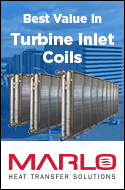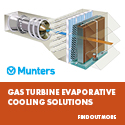FAQS
Wetted-Media Direct Evaporative Cooling
Q1: Does this technology only work in dry climates?
A1: Direct evaporative technology works when it is not raining or below 40 deg F . During the hottest part of the day, when the maximum turbine output is needed, the temperature difference between the dry bulb and wet bulb is at its greatest. It is the difference in these 2 temperature measurements that allows for direct evaporative technology to do its work to cool the inlet air. In arid environments, the number of hours where this technology is advantageous is greater than that in humid environments; however, direct evaporative technology can be a massive aid during the hottest part of the day in most climates.
Q2: How long does the direct evaporative media last?
A2: With proper water quality management, the average life is 3 to 5 years.
Q3: How much water do these systems use?
A3: This is dependent on the air flow, climate and media depth. System providers can provide precise calculations to provide water usage. A rule of thumb is 1.2 gallons per hour per 10,000 cfm per degree F of cooling or 1.2 * (T1-T2) * CFM /10,000
Q4: Do these systems require pure water?
A4: No. Most direct evaporative systems use site access water whether well or municipal. This said, it is important to work with your system provider in assessing the water quality to determine the amount of water bleed or chemical treatment if necessary.
Q5: Is this technology only for new installations?
A5: Direct evaporative cooling applies to both existing and new installations. In retrofit projects, systems are integrated into the inlet structure with adjustments and modification to the support structure. Some are installed in front of the inlet filters and others are installed after the inlet filters. If installed in the pre-position, it is necessary to have filters constructed of a polymer vs a paper element.
Q6: Isn’t there concerns with water carrying downstream into the turbine?
A6: System designers and providers will insure that the air velocity is within the design limits of the direct evaporative media. In most cases, a drift eliminator is installed for insurance.
Q7: Are these systems expensive?
A7: Direct evaporative cooling is one of the least costly to install and the least costly to operate of all other available technologies.
Q8: What about maintenance?
A8: Direct evaporative cooling technology requires little in the way of maintenance. Most operations conduct a yearly shut down and start up. During start up, checking for adequate water flow is the priority as well as a general overview. Annual inspection of the media is recommended as is a periodic test of the makeup water to insure adequate chemistry.




